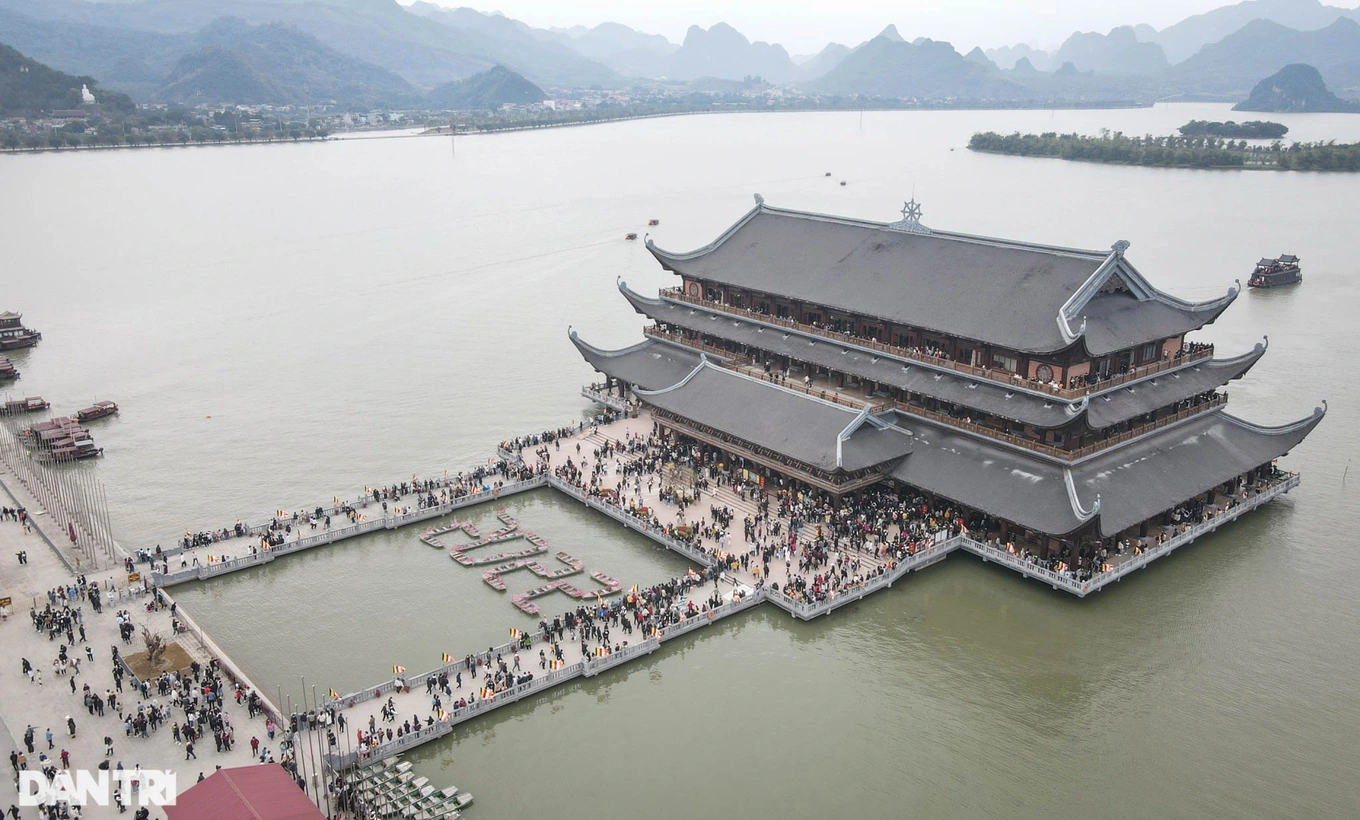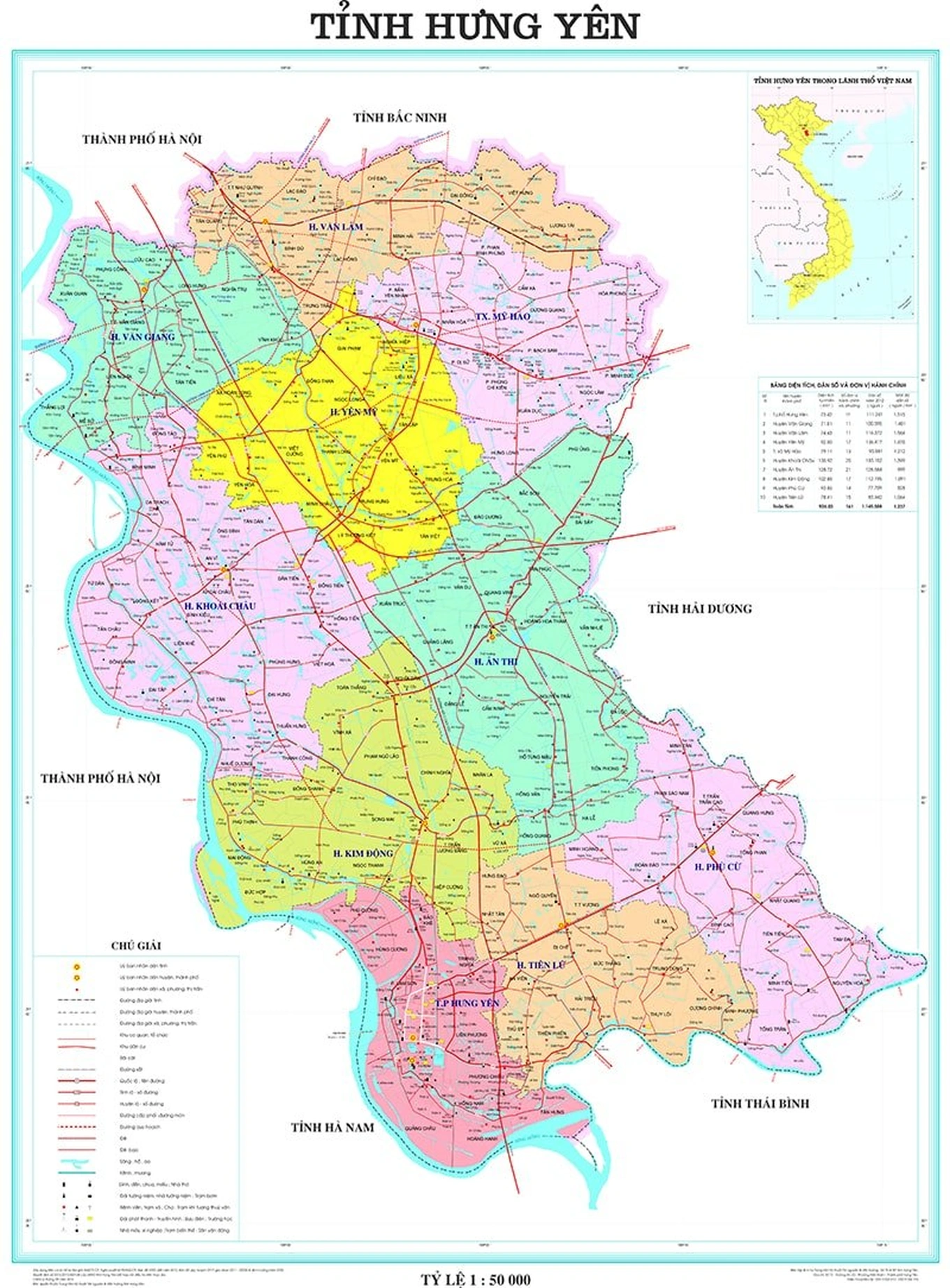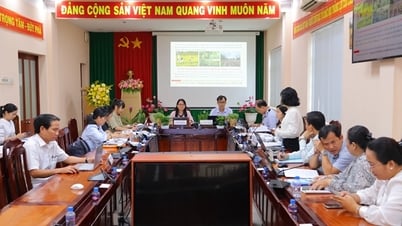When the Ministry of Home Affairs drafted a resolution of the National Assembly on provincial-level administrative unit standards in 2021, these four provinces bordering the capital Hanoi were all included in the list of merger studies due to their small area.
Ha Nam province has a natural area only larger than Bac Ninh province . However, this province has the fewest district-level administrative units in the country - 6 districts (lower than the standard number of district-level administrative units in the province of 9 districts).
Specifically, Ha Nam has 4 districts including Kim Bang, Thanh Liem, Ly Nhan, Binh Luc; Duy Tien town and Phu Ly city.
Tam Chuc Pagoda, Ha Nam province (Photo: Manh Quan).
During its development history, Ha Nam has undergone many changes in place names and administrative boundaries. On October 20, 1890, Ha Nam province was established under Article I of the Decree of the Governor General of Indochina on the basis of the entire land of Ly Nhan prefecture, two cantons of Phu Xuyen, including 5 districts of Kim Bang, Duy Tien, Ly Nhan, Binh Luc, Thanh Liem and the provincial capital Phu Ly.
After the August Revolution in 1945, to meet the requirements of revolutionary tasks, the Party and State changed and adjusted the administrative boundaries of Ha Nam province several times.
In 1965, Ha Nam merged with Nam Dinh province to form Nam Ha province. In 1976, this province merged with Ninh Binh province to form Ha Nam Ninh province.
In 1991, Ha Nam Ninh was split into two provinces, Nam Ha and Ninh Binh. In 1997, the National Assembly agreed to split Nam Ha province to re-establish the two provinces of Ha Nam and Nam Dinh as they are today.
Ha Nam has a population of about 0.85 million, located more than 50km from the center of Hanoi and is considered the southern gateway of the capital.
Ha Nam currently does not meet all three criteria of natural area, population and number of district-level administrative units, according to the National Assembly's resolution on provincial-level administrative unit standards.
Hung Yen province has 8 districts including An Thi, Khoai Chau, Kim Dong, Phu Cu, Tien Lu, Van Giang, Van Lam, Yen My; My Hao town and Hung Yen city.
Hung Yen was established in the 12th year of Minh Mang (1831). From the 16th to 17th centuries, Hung Yen was known by the place name Pho Hien with the saying "First the Capital, second Pho Hien", a famous trading port at one time, the largest in Dang Ngoai, with bustling trading activities with many countries in the world and quickly became a prosperous urban area - a small Trang An.
Administrative map of Hung Yen province (Photo: Hung Yen Provincial People's Committee).
Hung Yen province was officially established in 1931. In early 1968, the National Assembly approved the merger of Hung Yen and Hai Duong provinces into Hai Hung province, with the provincial capital located in Hai Duong town.
In early 1997, Hung Yen province was re-established. In February 1997, the Government agreed to split Phu Tien district into two districts, Phu Cu and Tien Lu; establish and adjust wards of Hung Yen town.
In mid-1999, the Government agreed to separate the two districts of My Van and Chau Giang into five districts: Van Lam, Van Giang, My Hao, Yen My and Khoai Chau.
In September 2003, the Government continued to adjust the administrative boundaries to expand Hung Yen town, establish wards, and adjust the administrative boundaries between wards of Hung Yen town.
In early 2009, Hung Yen city under Hung Yen province was established. Hung Yen province currently has a population of over 1.29 million people.
Vinh Phuc province was established on February 12, 1950, on the basis of merging Vinh Yen and Phuc Yen provinces. In February 1968, Vinh Phuc province merged with Phu Tho province to form Vinh Phu province.
From January 1, 1997, Vinh Phuc province was re-established. In September 1998, Tam Dao district was divided into two districts, Tam Duong and Binh Xuyen. On December 9, 2003, the Government issued a decree to establish Phuc Yen town and the new Tam Dao district.
On December 1, 2006, the Government issued a decree to establish Vinh Yen city, Vinh Phuc province.
In 2008, implementing the Party and State's policy on expanding Hanoi's administrative boundaries, Me Linh district of Vinh Phuc province was transferred to Hanoi capital.
Vinh Phuc province currently has 9 administrative units, including two cities (Vinh Yen, Phuc Yen) and 7 districts (Tam Duong, Tam Dao, Yen Lac, Vinh Tuong, Lap Thach, Song Lo, Binh Xuyen).
Tam Dao Castle, a famous construction in Tam Dao district, Vinh Phuc (Photo: Lac Hong).
Vinh Phuc has great potential in natural and human tourism resources. Up to now, Vinh Phuc still bears the strong imprint of Hung Vuong and Kinh Bac, Thang Long culture, of unique folk culture, of mandarin examinations, with social lifestyle and ethical standards always preserved.
This locality also has a famous complex of natural landscapes and landscapes: Tam Dao National Park, Ban Long Waterfall, Dai Lai Lake, Lang Ha Lake... Many folk festivals imbued with national identity and many historical and cultural relics bearing historical imprints and spiritual values such as: Tay Thien Scenic Area, Binh Son Tower, Tran Nguyen Han Temple, Dong Dau Archaeological Site...
Vinh Phuc currently has a population of about 1.2 million people.
Politburo sets deadline for reporting provincial mergers
As Dan Tri reported, the Politburo and the Secretariat requested to develop a project to merge some provincial-level administrative units, not organize the district level, and continue to merge commune-level administrative units.
For the provincial level, the Politburo and Secretariat believe that in addition to the basis of population size and area, it is necessary to carefully study the national master plan, regional planning, local planning, socio-economic development strategy, and sectoral development.
Another factor that needs to be taken into account is the expansion of development space, promotion of comparative advantages, meeting development requirements for each locality and the requirements and development orientation of the new stage... as a basis and scientific basis for arrangement.
The Politburo and the Secretariat requested to absorb comments from provincial and municipal Party Committees, Party Committees directly under the Central Committee, agencies, organizations, and Central Party Committees, complete the project, and report to the Politburo and the Secretariat before March 27.
The work of absorbing the opinions of the Politburo, the Secretariat, and agencies, completing the project, the report, and submitting it to the Party Central Committee (through the Central Organizing Committee) must be completed before April 7.
Dantri.com.vn






![[Photo] General Secretary To Lam attends the conference to review 10 years of implementing Directive No. 05 of the Politburo and evaluate the results of implementing Regulation No. 09 of the Central Public Security Party Committee.](https://vphoto.vietnam.vn/thumb/1200x675/vietnam/resource/IMAGE/2025/5/19/2f44458c655a4403acd7929dbbfa5039)
![[Photo] President Luong Cuong presents the 40-year Party membership badge to Chief of the Office of the President Le Khanh Hai](https://vphoto.vietnam.vn/thumb/1200x675/vietnam/resource/IMAGE/2025/5/19/a22bc55dd7bf4a2ab7e3958d32282c15)
![[Photo] Close-up of Tang Long Bridge, Thu Duc City after repairing rutting](https://vphoto.vietnam.vn/thumb/1200x675/vietnam/resource/IMAGE/2025/5/19/086736d9d11f43198f5bd8d78df9bd41)

![[Photo] Panorama of the Opening Ceremony of the 43rd Nhan Dan Newspaper National Table Tennis Championship](https://vphoto.vietnam.vn/thumb/1200x675/vietnam/resource/IMAGE/2025/5/19/5e22950340b941309280448198bcf1d9)































![[Photo] Prime Minister Pham Minh Chinh inspects the progress of the National Exhibition and Fair Center project](https://vphoto.vietnam.vn/thumb/1200x675/vietnam/resource/IMAGE/2025/5/19/35189ac8807140d897ad2b7d2583fbae)














































![[VIDEO] - Enhancing the value of Quang Nam OCOP products through trade connections](https://vphoto.vietnam.vn/thumb/402x226/vietnam/resource/IMAGE/2025/5/17/5be5b5fff1f14914986fad159097a677)





Comment (0)